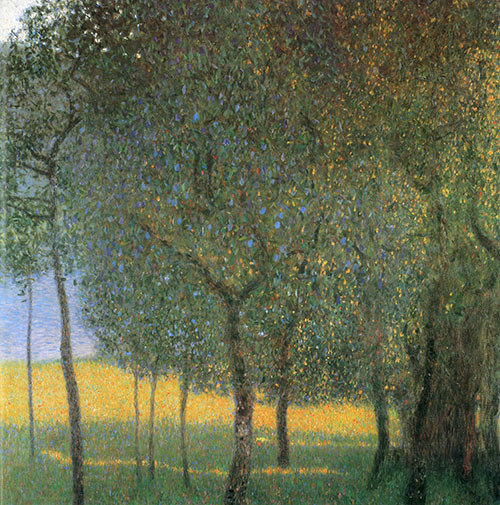Fruit Trees
The artist, Gustav Klimt's art nouveau style in the painting Fruit Trees was conceived in 1901 and illustrates the calm countryside the artist was captured by. The oil on canvas piece was produced during Klimt's gold phase, however illustrates a prominent landscape engulfed in fruit trees as the focal point of the piece.
The painting illustrates a rich landscape, with a prominent fruit tree catching the viewer's attention. The tree seems to resemble a green apple tree, a classic piece that Klimt spent an immense amount of time painting. The apple tree symbolized purity and life for the artist, a theme he loved to paint as he seeked the elements within his own life.
Klimt experienced an array of sorrows, through the death of his own son at a young age, to the rapid death of his own brother and father that spring his sister and mother into a deep depression, continuing the agony to himself catching the syphilis disease at the time. The apple tree throughout his work are said to symbolize a gently pure life that he desires, cultivating the simple elements in life such as the apple tree that bares the fresh fruit.
While the tree within Fruit Trees resembles an apple tree, the fruit is coloured a strong shade of blue in small spots, bringing into question what fruit it holds. Perhaps the small blue spots are meant for an artist pinch, adding a pop of colour to the tree. Or, the piece may represent an allegory of nature, forcing the viewer to see the pieces in an altered state and wonder what the philosophical significance behind the piece is.
To the right of the painting, a tall tree stands with its branches falling apple the blue-fruited tree. Small glimpse of arrange are painted along the branches, perhaps exposing an apricot tree. The trees around the perimeter of the focal point tree are painted in darker shades of green, creating a more forestry feel. The grass is covered in a light shade of green, painted by small brush strokes quickly moving vertically to crate the appeal of grass.
Minor dots of colour cover the grass, most likely illustrating the fallen blue and orange fruit. Towards the background of the grass, depth is added as Klimt paints a yellow rich field. It is unknown of whether this field is simply illuminated by the son, whereas the green patch of grass is in an area of shade, or if the field illustrates another form of vegetation such as wheat.
The background of the piece progresses into a light shade of blue, illustrating a body of water. A viewer can argue that the blue in the piece illustrates the sky, however a horizon is not painted. As well, a light shade of blue mixed with white begins at the bottom of the water, illustrating a shallow area before the water transcends into a deeper area.
It is difficult for the viewer to exactly witness what is occurring in the background, as Klimt did not use an array of detail to properly illustrate the background. The form of the painting remains flat, only deepened between the yellow field and the shades patch of grass. Nevertheless, Klimt's impressionist technique is immensely showcased through his painting of the landscape.




